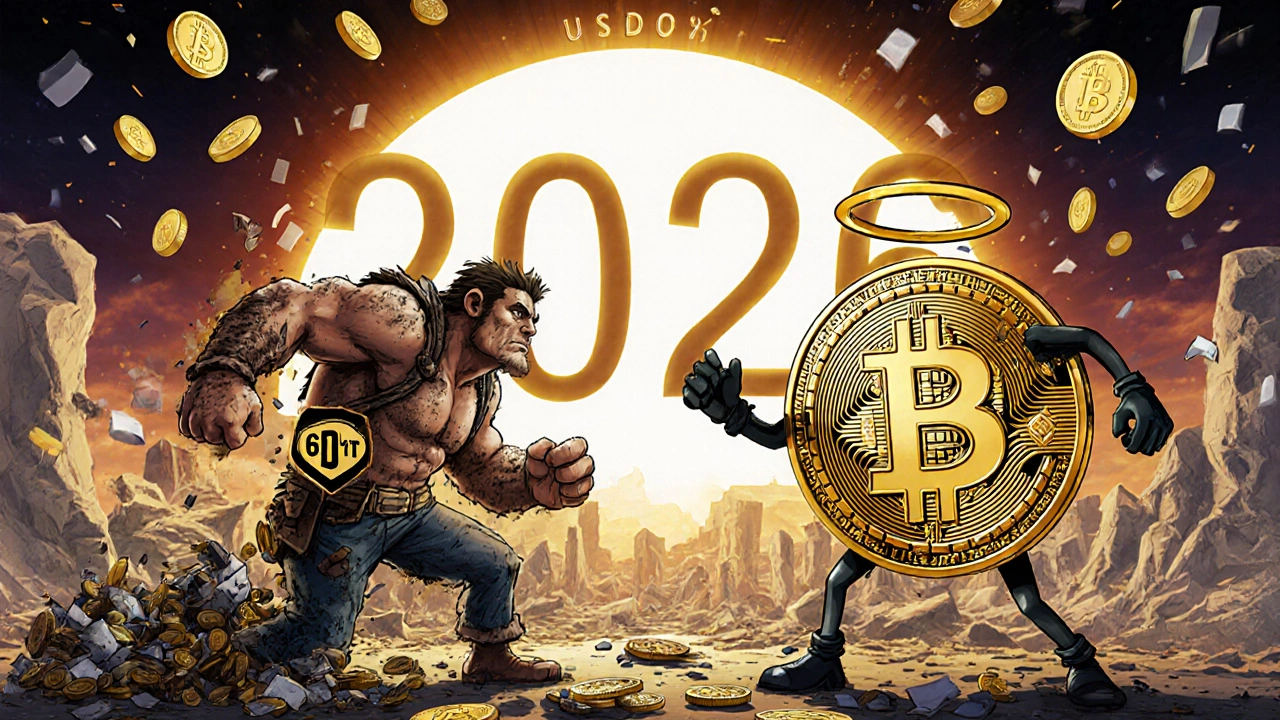What Is USDT vs USDC: The Real Difference Between the Two Biggest Stablecoins
 Nov, 4 2025
Nov, 4 2025
When you buy Bitcoin or Ethereum, its price swings wildly. One day it’s $60,000, the next it’s $55,000. That’s fine if you’re betting on long-term growth. But what if you just want to move money in crypto without losing value? That’s where stablecoins come in. And of all stablecoins, two dominate: USDT and USDC. They both claim to be worth exactly $1. But they’re not the same. Knowing the difference isn’t just technical-it affects your money.
What Is USDT?
USDT, or Tether, is the oldest and largest stablecoin by volume. It was launched in 2014 by Tether Limited, a company tied to the crypto exchange Bitfinex. For years, people used it to move money between exchanges without converting to fiat. It’s the go-to for traders who need fast, cheap transfers.
Each USDT is supposed to be backed by one U.S. dollar. But here’s the catch: Tether doesn’t keep all that cash in a bank. Their reserves include commercial paper, loans, corporate bonds, and even gold. In 2021, after years of scrutiny, Tether admitted only about 75% of its reserves were in cash and cash equivalents. The rest? Riskier assets. That’s why some call USDT a “fractional reserve” stablecoin.
It’s not illegal. But it’s not transparent. Tether has been fined $41 million by the CFTC for misleading claims about its reserves. Even so, USDT still makes up over 60% of all stablecoin trading volume. Why? Because it’s everywhere-on every exchange, in every wallet, in every DeFi protocol. If you need liquidity fast, USDT is the default.
What Is USDC?
USDC, or USD Coin, was launched in 2018 by Circle and Coinbase. It was built with regulation in mind. Unlike Tether, Circle publishes monthly third-party audits by Grant Thornton. Every USDC is backed 1:1 by cash and short-term U.S. Treasuries. No commercial paper. No corporate loans. Just safe, liquid assets.
Circle is a regulated financial company. It follows U.S. banking rules. If you hold USDC, you’re essentially holding a digital version of a bank deposit-but one that works on blockchains. It’s not perfect: Circle can freeze addresses if required by law. But that’s part of the trade-off. USDC is designed to work inside the traditional financial system, not outside it.
USDC is used heavily in DeFi, institutional crypto, and regulated platforms like Coinbase and Kraken. It’s the stablecoin of choice for businesses that need compliance. If you’re running a crypto payroll system, paying creators, or storing funds in a wallet that reports to the IRS, USDC is the safer bet.
USDT vs USDC: The Key Differences
Here’s how they stack up side by side:
| Feature | USDT (Tether) | USDC (Circle) |
|---|---|---|
| Issuer | Tether Limited | Circle (with Coinbase) |
| Launch Year | 2014 | 2018 |
| Reserve Composition | Cash, commercial paper, bonds, gold | Cash, U.S. Treasury bills |
| Transparency | Annual attestation (not full audit) | Monthly third-party audits |
| Regulatory Status | Fined by CFTC, limited oversight | Regulated financial company, licensed in U.S. |
| Freeze Capability | Yes, but rarely used | Yes, by law (e.g., OFAC compliance) |
| Market Share (2025) | ~62% | ~32% |
USDT is the workhorse. USDC is the compliant cousin. You can think of it like this: USDT is the cash you keep in your sock drawer-convenient, but no one knows exactly what’s behind it. USDC is the money in your FDIC-insured bank account-slower to move, but you know it’s there.

Why Does This Matter to You?
If you’re just holding crypto for a few days and trading, USDT’s speed and liquidity make sense. It’s the default because it’s everywhere. But if you’re holding for weeks or months-if you’re storing life savings in crypto-then USDC’s transparency matters.
Think about 2022. When TerraUSD collapsed, the whole market panicked. USDT briefly dropped to $0.95 because people feared it wasn’t backed. Even though it recovered, the panic showed how fragile trust can be. USDC didn’t waver. It stayed at $1.00 because people knew exactly what backed it.
For businesses, the difference is even clearer. PayPal, Shopify, and Stripe all support USDC. They don’t support USDT. Why? Because USDC meets financial compliance standards. If you’re building a crypto app, accepting payments, or paying freelancers, choosing USDC reduces legal risk.
Even regulators are pushing for USDC-style models. The U.S. Treasury now requires stablecoin issuers to hold 100% reserves in cash and short-term Treasuries. That’s exactly what USDC does. Tether is scrambling to catch up.
Which One Should You Use?
Here’s a simple rule:
- Use USDT if you’re trading frequently, moving funds between exchanges, or need maximum liquidity. It’s the fastest, most widely accepted option.
- Use USDC if you’re holding, saving, earning yield, or using crypto for real-world payments. You want to know your money is safe and transparent.
Many people hold both. They keep most of their stablecoin balance in USDC and use USDT only for short-term trades. That’s smart. It gives you the best of both worlds.
Don’t assume both are equal just because they’re both called “USD.” One is built for speed. The other is built for trust. And in crypto, trust is worth more than liquidity.

What Happens If One Fails?
USDT has a bigger risk profile. If Tether ever lost access to its reserves-or if the commercial paper it holds defaults-it could trigger a chain reaction. Trillions of dollars in crypto rely on USDT. A collapse would shake the entire market.
USDC is less risky. If Circle ever had a problem, the U.S. government would step in. It’s too big to fail. It’s tied to the banking system. That’s why Circle can afford to be more transparent: they know regulators are watching.
That doesn’t mean USDC is perfect. It can freeze your funds. If you’re using it for privacy-focused activities, that’s a dealbreaker. But if you want your money to be secure and legal, USDC is the better choice.
Future Outlook
The crypto world is changing. More countries are moving toward regulated stablecoins. The EU’s MiCA law, the U.S. stablecoin bill, and global standards are pushing issuers toward transparency. Tether is under pressure to clean up its reserves. Circle is already there.
By 2026, USDC could overtake USDT in market share. Not because it’s faster-but because it’s safer. And in finance, safety wins in the long run.
Is USDT really backed by $1?
Tether claims each USDT is backed by $1, but its reserves include risky assets like commercial paper and corporate bonds-not just cash. In 2021, Tether admitted only 75% of its reserves were cash or cash equivalents. That means USDT is not fully backed by physical dollars.
Is USDC safer than USDT?
Yes, USDC is safer because it’s backed 1:1 by cash and U.S. Treasury bills, and it’s audited monthly by Grant Thornton. Tether’s audits are annual and less detailed. USDC also operates under U.S. financial regulations, making it more reliable during market stress.
Can USDC be frozen?
Yes. Circle, the issuer of USDC, can freeze addresses if required by law-like if a wallet is linked to sanctioned entities under OFAC rules. This is a trade-off for regulatory compliance. USDT can also freeze addresses, but it rarely does so publicly.
Why do exchanges prefer USDT?
USDT has been around longer and is accepted on almost every exchange worldwide. It’s the most liquid stablecoin, so traders use it to move in and out of positions quickly. Many smaller exchanges don’t support USDC because of compliance requirements.
Should I switch from USDT to USDC?
If you’re trading daily, stick with USDT for liquidity. But if you’re holding, earning yield, or using crypto for payments, switch to USDC. It’s more transparent, regulated, and less likely to lose its peg during a crisis. Many users now hold both: USDC for savings, USDT for trading.
Rajat Patil
November 7, 2025 AT 13:56USDT is like that friend who always has cash but you're not sure if it's real or play money. USDC is the one who shows you the bank statement. I keep both, but my savings? All USDC. Better sleep at night.
deepak srinivasa
November 9, 2025 AT 04:37I never thought about the reserve composition until I read this. Why does it matter if it's commercial paper or Treasuries? Isn't it still $1? I'm confused now.
pk Pk
November 10, 2025 AT 17:36Listen, if you're trading every day, USDT is your best friend. Fast, cheap, everywhere. But if you're holding for months? USDC. No drama. No panic. No ‘did they really have the money?’ moments. Just clean, regulated, boring money. And boring is good when your rent depends on it.
NIKHIL TRIPATHI
November 12, 2025 AT 15:41I used to use USDT because everyone else did. Then I got scared after the Terra crash. Now I keep 80% in USDC, 20% in USDT for quick swaps. It’s not about trust, it’s about risk distribution. Smart money doesn’t put all its eggs in one basket, even if that basket is called ‘stable’.
Also, if you’re using crypto for business, USDC isn’t optional. PayPal won’t touch USDT. Stripe won’t touch USDT. Your accountant will cry if you use USDT. Just sayin’.
Shivani Vaidya
November 13, 2025 AT 08:28USDC can freeze your funds. That’s a feature not a bug. If you’re doing something shady, you should be frozen. If you’re doing something legal, you’ll never get frozen. Simple.
Rubina Jadhav
November 14, 2025 AT 16:34USDT is faster. USDC is safer. I use both. Done.
sumraa hussain
November 15, 2025 AT 04:51USDT is the wild west cowboy… USDC is the suit-wearing banker with a clipboard and a lawyer on speed dial… and honestly? I’d rather have the banker holding my cash when the apocalypse hits… even if he’s a little too eager to check my ID every time I move a dime.
Raji viji
November 15, 2025 AT 22:52Ugh. Another ‘USDC is safer’ post. Newsflash: Tether’s reserves are fine. The CFTC fine? That was a political circus. USDT has more liquidity than your entire bank account. You people are scared of auditors like they’re monsters. Wake up. USDT moves markets. USDC just sits there looking pretty.
Also, ‘regulation’ is just a fancy word for ‘government control.’ You want to be owned? Go ahead. I’ll be over here trading with real money.
Rajashree Iyer
November 17, 2025 AT 06:24Is money really money if it’s not backed by trust? And is trust something you can audit? Or is it just a feeling you get when someone says ‘I promise’? USDT is the echo of capitalism’s shadow. USDC is its polished reflection. But which one is the real thing? Or are we all just ghosts in the blockchain machine?
Parth Haz
November 18, 2025 AT 22:23For retail users, the choice is simple: USDT for trading, USDC for holding. For institutions, USDC is non-negotiable. The market is slowly shifting toward compliance. Tether will adapt or fade. History favors the transparent.
Vishal Bharadwaj
November 20, 2025 AT 01:49USDT is 62% market share? LOL. That’s because most exchanges are still in 2017. Once they get real compliance, USDC will be 80% by 2026. And guess what? The people who still use USDT will be the same ones who still use MySpace. Also, ‘commercial paper’? That’s just a fancy word for ‘I borrowed money from a guy I met at a crypto conference.’
anoushka singh
November 20, 2025 AT 15:11Wait so if USDC can freeze my wallet… can they freeze my whole crypto life? Like… what if I just want to send $10 to my cousin in Nepal? Will the government stop me? This feels… invasive. 😔
Jitendra Singh
November 21, 2025 AT 03:57Good breakdown. I’ve been using USDT since 2020. After reading this, I’m moving 70% to USDC this week. Better safe than sorry. Thanks for the clarity.